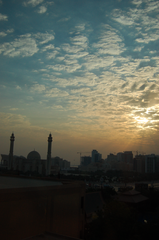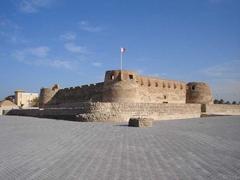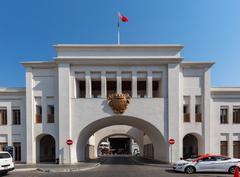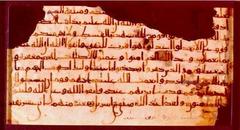Qal’at Al Bahrain: Visiting Hours, Tickets, and Comprehensive Guide to Bahrain’s Premier Historical Site
Date: 14/06/2025
Introduction
Qal’at Al Bahrain, also known as Bahrain Fort, is a UNESCO World Heritage Site and one of the Gulf region’s most significant archaeological landmarks. Located on Bahrain Island’s northern coast, this site encompasses over 4,000 years of continuous human settlement. As the ancient capital of the Dilmun civilization and a strategic port through the ages, Qal’at Al Bahrain invites visitors to journey through layers of history, from the Bronze Age to the Islamic, Portuguese, and Persian periods (UNESCO; TouristLink).
This guide covers everything you need to know about Qal’at Al Bahrain: historical context, visiting hours, ticket details, accessibility, site facilities, nearby attractions, and practical travel tips. Whether you are a history enthusiast, cultural traveler, or first-time visitor, Qal’at Al Bahrain promises an immersive and enriching experience.
Contents
- Historical Overview
- Origins and Early Settlement
- The Dilmun Civilization
- Successive Civilizations
- Portuguese and Persian Eras
- Archaeological Excavations and UNESCO Status
- Visiting Information
- Operating Hours
- Tickets and Admission
- Accessibility Features
- Site Facilities and Amenities
- Guided Tours and Special Events
- Photography Tips
- What to See and Do
- The Tell and Archaeological Layers
- The Portuguese Fort
- The Ancient Harbour
- Palm Groves and Landscape
- Qal’at Al Bahrain Site Museum
- Nearby Attractions
- Travel Tips and Practical Advice
- Frequently Asked Questions (FAQ)
- Summary and Conclusion
- Sources and Further Reading
Historical Overview
Origins and Early Settlement
Qal’at Al Bahrain is a remarkable archaeological mound (tell) formed by successive layers of human habitation dating back to at least 2300 BCE. Its location at the crossroads of trade routes between Mesopotamia, the Indus Valley, and the Arabian Peninsula made it a prominent settlement and trading hub (Everything Everywhere).
The Dilmun Civilization
During the Dilmun period (c. 2300–1600 BCE), Qal’at Al Bahrain was the civilization’s capital. Ancient Sumerian and Babylonian texts describe Dilmun as a land of prosperity and mythical importance. Excavations have uncovered administrative buildings, religious sites, and rich burial traditions, including the nearby Dilmun Burial Mounds (Countryaah). Dilmun’s wealth stemmed from its role as a center for copper, pearls, and date trading.
Successive Civilizations
Following Dilmun’s decline, the site saw continued occupation through the Tylos (Hellenistic), Parthian, Sassanian, and Islamic periods. Urban renewal, changing architectural styles, and new religious buildings reflected these influences (TouristLink; Keralam Chronicles).
Portuguese and Persian Eras
In the 16th century, the Portuguese built the fort that dominates the site today, fortifying Bahrain’s coastline for strategic control of Gulf trade routes. The fort’s bastions, towers, and thick walls are classic examples of Portuguese military architecture adapted to local needs (Everything Everywhere). Persian forces later captured and maintained the fort, preserving its importance as a regional stronghold (TouristLink).
Archaeological Excavations and UNESCO Status
Since the 1950s, international teams have uncovered only about 25% of the site, revealing residential quarters, workshops, temples, and thousands of artifacts. Qal’at Al Bahrain was inscribed as a UNESCO World Heritage Site in 2005, recognized for its exceptional testimony to cultural interchange and urban evolution over millennia (UNESCO; World Atlas).
Visiting Information
Operating Hours
- Fort and Archaeological Site: Open Tuesday to Sunday, 12:00 PM to 6:00 PM; closed Mondays.
- Site Museum: Open similar hours; check ahead for public holidays and Ramadan variations (LocalBH).
Tickets and Admission
- Fort: Admission is free.
- Site Museum: Entry fee is minimal (a few BHD); children may enter free or at reduced rates.
- Where to Buy: Tickets for the museum can be purchased at the entrance. Confirm prices and schedules on the official museum website or call +973 17298545.
Accessibility Features
- Parking: Ample parking for private vehicles and tour buses.
- Wheelchair Access: The museum is fully accessible; the fort’s ancient terrain can be uneven and challenging for visitors with limited mobility.
- Restrooms: Modern, clean facilities are available at the museum.
Site Facilities and Amenities
- Audio Guides: Available for rent at the museum in multiple languages.
- Guided Tours: Can be arranged in advance or through local operators.
- Café: Seaside café offering refreshments and light meals with views of the fort and palm groves.
- Gift Shop: Sells books, souvenirs, and local handicrafts.
Guided Tours and Special Events
- Guided Tours: Enhance your experience with in-depth historical insights.
- Special Events: Cultural festivals, workshops, and lectures are occasionally organized; check the Bahrain Authority for Culture and Antiquities for updates.
Photography Tips
- Photography is allowed throughout the site and museum. Sunset from the ramparts provides stunning views.
- Drone use is restricted and requires permission.
What to See and Do
The Tell and Archaeological Layers
The mound reveals seven major occupational layers, each representing distinct civilizations. Explore exposed excavation zones, ancient streets, city walls, and remnants of public and residential buildings (Barceló Guide; UNESCO).
The Portuguese Fort
The 16th-century fort is the site’s architectural highlight. Walk the ramparts for panoramic views, explore chambers and towers, and learn about its military significance through interpretive panels (Barceló Guide).
The Ancient Harbour
Qal’at Al Bahrain’s ancient harbour and offshore sea-tower (once a watchtower or lighthouse) underscore its role as a maritime trading hub (UNESCO). Though the sea-tower is not open to the public, it can be seen from the fort.
Palm Groves and Landscape
Lush palm groves and agricultural gardens surround the site, reflecting Bahrain’s long-standing agricultural traditions. Ancient date syrup installations (madbasa) can be found within the site (UNESCO).
Qal’at Al Bahrain Site Museum
Five exhibition halls display over 500 artifacts, from Dilmun pottery and jewelry to Hellenistic and Islamic relics (Barceló Guide). Interactive exhibits, models, and audio guides provide context for all ages. The seaside café and gift shop round out the visitor experience (Bahrain Authority for Culture and Antiquities).
Nearby Attractions
- Dilmun Burial Mounds: Explore extensive prehistoric cemeteries nearby (Countryaah).
- Bahrain National Museum: Offers a broader perspective on the island’s history.
- Manama Souqs: Experience local culture and crafts.
- Other Sites: Barbar Temple, A’ali Burial Mounds, and Al-Fateh Mosque (Trip101; TripXL).
Travel Tips and Practical Advice
- Best Time to Visit: November–March for cooler weather; avoid midday heat in summer.
- Dress Code: Modest attire (shoulders/knees covered) is recommended.
- Health and Safety: Wear sturdy footwear, carry water, and use sun protection.
- Getting There: Located in the Seef district, approx. 15–20 minutes by car from Manama. Public transport is limited; taxis or ride-hailing services are preferable.
- Budget: Entry to the fort is free; museum fees are minimal.
Frequently Asked Questions (FAQ)
Q: What are the Qal’at al-Bahrain visiting hours?
A: Tuesday to Sunday, 12:00 PM–6:00 PM; closed Mondays.
Q: How much do tickets cost?
A: Fort entry is free; museum charges a nominal fee (discounts for children).
Q: Are guided tours available?
A: Yes, through prior arrangement or at the museum.
Q: Is the site wheelchair accessible?
A: The museum is accessible; the fort has uneven terrain.
Q: Can I take photographs at Qal’at al-Bahrain?
A: Yes, photography is allowed; drones require permission.
Q: How do I get there from Manama?
A: 15–20 minutes by car or taxi from central Manama.
Summary
Qal’at Al Bahrain is a testament to Bahrain’s enduring legacy as a crossroads of ancient civilizations. Its multilayered archaeological tell, imposing Portuguese fort, and acclaimed museum offer a rich, immersive experience for all visitors. With free entry to the fort, minimal museum fees, accessible facilities, and proximity to other cultural sites, Qal’at Al Bahrain is a must-see on any Bahrain itinerary. Plan your visit during cooler months, wear comfortable shoes, and take advantage of guided tours or audio guides for the best experience (UNESCO; World Atlas; TouristLink; Bahrain Authority for Culture and Antiquities).
To stay updated on events and archaeological news, download the Audiala app and follow official channels. Extend your cultural journey by exploring related sites like the Dilmun Burial Mounds and Bahrain National Museum.
Sources and Further Reading
- Qal’at Al Bahrain: Visiting Hours, Tickets, and History of Bahrain’s Ancient Fort, 2025, TouristLink
- Qal’at al-Bahrain Visiting Hours, Tickets & History of Bahrain’s UNESCO Archaeological Site, 2025, UNESCO
- Qal’at al-Bahrain: Visiting Hours, Tickets, and Exploring Manama’s Premier Historical Site, 2025, Bahrain Authority for Culture and Antiquities
- Qal’at al-Bahrain Visiting Hours, Tickets, and Guide to Bahrain’s Historic Fort, 2025, LocalBH
- Qal’at al-Bahrain Ancient Harbour and Capital of Dilmun World Heritage Site, 2025, Everything Everywhere
- Discovering Bahrain’s Historical Places, 2025, TripXL
- Famous Landmarks in Bahrain, 2025, Countryaah
- How to Visit Bahrain Fort, 2025, Keralam Chronicles
- UNESCO World Heritage Sites in Bahrain, 2025, World Atlas
- Things to Do in Manama Bahrain, 2025, Trip101
- Bahrain Fort: A vivid testament to civilisation, 2025, Bahrain News Agency
- Bahrain Fort Ancient Castle and Capital of Dilmun, 2025, Ootlah
- You Can Check Out Ancient Dilmun Artifacts at the Qalat Al Bahrain Site Museum, 2025, LocalBH
For further exploration, check out our guides to Bahrain Historical Sites and A’ali Burial Mounds. Take a virtual tour of Qal’at al-Bahrain and download the Audiala app for interactive maps, self-guided tours, and up-to-date visitor information.




